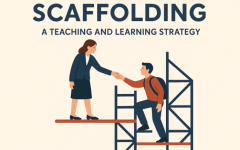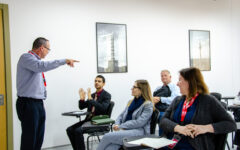Teaching and Learning Bulletin
25/09/2025 2025-09-25 14:44Teaching and Learning Bulletin
Placing our students at the heart of the learning process. Active Learning: what it is, why it matters
Welcome to this edition of our Teaching and Learning Bulletin (now shared as a blog).
Our aim is to offer ideas and approaches that can enrich our students’ learning experiences and encourage us to look at our teaching and learning practices from fresh perspectives.
Building on discussions from our recent Teaching and Learning session during staff induction week, I’d like to continue embedding into our Teaching and Learning ethos the concept of active learning. This is an approach that places our students at the heart of the learning process. As a reminder of what we explored together, you’ll find below an overview of what active learning is, why it matters, and how we can begin to embed it meaningfully in our classrooms.
What is active learning?
Active learning places students at the centre of the educational process. Instead of sitting back as information is passively provided to them, students are encouraged to interact with content through tasks that require reflection, application, and collaboration.
This approach is grounded in constructivist learning theory, which recognises that learners build new knowledge by connecting it to what they already know (Bransford, Brown, & Cocking, 1999). Social constructivism, as articulated by Vygotsky (1978), adds that learning is shaped through interaction — reinforcing the value of collaborative and cooperative environments in our classrooms.
In practice, active learning can take on many forms from pair work and structured discussions, group problem-solving, debates, to case studies and case-based tasks. What matters is that students are thinking with the material, not just about it.
Why does active learning matter?
There is a growing body of evidence showing the impact of active learning. Freeman et al. (2014) found that it significantly improves student performance and reduces failure rates compared to traditional lectures. Similarly, Prince (2004) and Michael (2006) argue that active learning not only promotes deeper understanding but also develops the transferable skills our graduates will need.
Importantly, the purpose of active learning goes beyond content mastery. It fosters critical thinking, problem-solving, and metacognitive awareness (Anderson et al., 2005; Kember & Leung, 2005). It also creates a more inclusive, motivating environment that benefits students from diverse backgrounds (Eddy & Hogan, 2014; Theobald et al., 2020). When students feel engaged and supported, they are more likely to take ownership of their learning.
How can we make active learning work?
While the benefits are clear, successful active learning requires intentional planning and facilitation. As lecturers, this means designing learning environments that encourage participation, risk-taking, and reflection. Activities should be aligned to learning outcomes and structured in ways that scaffold students’ engagement, giving them the confidence to participate fully.
It can be tempting to see active learning as a single strategy or activity. In reality, it is a mindset that places our students as active participants in constructing their own learning journeys. This said, on the TLC Moodle page you will find practical examples of active learning. These examples range from project-based assignments where students participate in real-life assignments, to in-class activities that encourage students to remain engaged and active during lectures and seminars. These types of activities include using online survey tools, like Kahoots, to present concept checking questions during the lecture or prompt discussion at the beginning of a session to raise awareness of misconceptions, shared understanding and individual knowledge. The examples also include think-pair-share questions that students can participate with during and towards the end of academic sessions.
How the Teaching and Learning Centre can support you
The Teaching and Learning Centre collaborates with you to provide training, support and guidance to help you plan, innovate and develop your use of active learning activities and techniques. Our aim is to work alongside you as you explore and embed new approaches in your teaching.
Throughout the academic year, we will run seminar sessions that bring colleagues together to share and learn from one another’s practice. These sessions will highlight different ways in which active learning can enhance our students’ experiences — from fostering deeper understanding to building their confidence and independence as learners.
By connecting theory with lived practice, and by learning from each other, we can build a vibrant, collaborative culture of active learning across our classrooms.
Moving Forward
As always, we hope this piece prompts fresh conversations in your teams and inspires you to try something new. If you would like to explore active learning further or discuss how it might work in your own teaching context, please do get in touch with us at the Teaching and Learning Centre, come along to our regular seminars or put your name forward to run a seminar in collaboration with us.
Let’s continue to learn from and with each other as we shape rich, engaging learning environments for our students.
Some Useful References:
Anderson, W.A., Mitchell, S.M. and Osgood, M.P., 2005. Comparison of student performance in cooperative learning and traditional lecture-based biochemistry classes. Biochemistry and Molecular Biology Education, 33(6), pp.387–393.
Bransford, J.D., Brown, A.L. and Cocking, R.R., 1999. How people learn: Brain, mind, experience, and school. Washington, DC: National Academy Press.
Brame, C.J., 2016. Active learning. Vanderbilt University Center for Teaching. Available at: https://cft.vanderbilt.edu/guides-sub-pages/active-learning/
Eddy, S.L. and Hogan, K.A., 2014. Getting under the hood: How and for whom does increasing course structure work? CBE—Life Sciences Education, 13(3), pp.453–468.
Freeman, S., Eddy, S.L., McDonough, M., Smith, M.K., Okoroafor, N., Jordt, H. and Wenderoth, M.P., 2014. Active learning increases student performance in science, engineering, and mathematics. Proceedings of the National Academy of Sciences, 111(23), pp.8410–8415.
Kember, D. and Leung, D.Y.P., 2005. The influence of active learning experiences on the development of graduate capabilities. Studies in Higher Education, 30(2), pp.155–170.
Kozanitis, A. & Nenciovici, L., 2023. Effect of active learning versus traditional lecturing on the learning achievement of college students in humanities and social sciences: A meta-analysis. Higher Education, 86, pp.547–569.
Michael, J., 2006. Where’s the evidence that active learning works? Advances in Physiology Education, 30(4), pp.159–167.
Prince, M., 2004. Does active learning work? A review of the research. Journal of Engineering Education, 93(3), pp.223–231.
Theobald, E.J., Hill, M.J., Tran, E., Agrawal, S., Arroyo, E.N., Behling, S., et al., 2020. Active learning narrows achievement gaps for underrepresented students in undergraduate science, technology, engineering, and math. Proceedings of the National Academy of Sciences, 117(12), pp.6476–6483.
Vygotsky, L.S., 1978. Mind in society: The development of higher psychological processes. Cambridge, MA: Harvard University Press.








